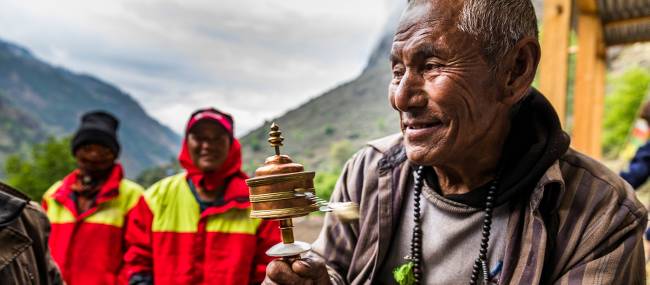
Villager in Nepal | Lachlan Gardiner
Blog home / Nepal Update: Returning to normal
NEPAL TREKS TO RUN AS NORMAL FROM SEPTEMBER
We are very pleased to announce that we will be operating all of our scheduled treks in
Nepal's Annapurna and Everest regions from September. A further final review will be conducted after the monsoon however no changes to this position are foreseen. We also wish to update those with bookings on treks in other regions.
As you may know from our previous updates, we have had staff out in the field reviewing the state of some of our main trekking regions following the earthquake. During these reviews we have focused on trail conditions, bridges, our private campsite infrastructure and the general state of community villages. We’ve also been keen to establish that the entry and departure points for our treks, being road access and air strips, are reliable. The international airport is fully functional and the Radisson Hotel in Kathmandu has received an official ‘green sticker’ which confirms it as structurally sound.
The Nepal government has also been undertaking its own surveillance and we are advised there was an official function in Kathmandu’s Durbar Square by the Tourism Minister where he announced that Nepal is safe for travel.
About 90% of Nepal’s 28 million people live in the foothills and mountain areas. Over centuries, they have established trade routes which in more recent history are the trails used by trekkers also. These trail networks are fundamentally important for trade, movement of goods, health and education and we know that any key mountain trails that have experienced damage will be repaired very quickly due to the complete reliance on them.
We are fortunate that in the Everest and Annapurna regions we have our private campsites which are all in good condition, with only minor repairs that are currently underway in two of our Everest camps. That work will be completed well before the season recommences. Otherwise, with our full service camping treks in all other regions we can continue to be as flexible as we need to be and not reliant on any private accommodation.
The Annapurna region: This area sustained very little affect from the earthquake, other than some damage to the village of Jomsom (on the Annapurna Circuit route) on the north western side of the Annapurna range. The area up around Manang is also reported to be mostly unaffected. Most of our treks in the region take place south of the Annapurna massif where all conditions are stable and in good condition for trekkers.
Everest region: There were two small landslips on the trails north of Lukla which have already been addressed by government appointed workers. Any danger has been removed and we have reports of trekkers and the normal stream of local people using these and all other trail networks in the region. There are some lodges, monasteries and schools that have been damaged throughout the area, but, we have assessed that they will not pose any risk to our operations. The Everest Base Camp is intact and we would like to highlight that the landslide that did occur post earthquake was at the base camp used by climbing expeditions, several hours hike above Gorak Shep, the highest village in which our trekkers sleep. With our guides up there last week we don’t see any issues visiting base camp or Kala Patar going forward. The Cho La pass that links the Everest and Gokyo valley is unaffected, as is the Renjo La pass linking the Gokyo and Thame Valleys. The Kongma La, being the pass between the Chukung Valley and Lobuche is also fine as per our Everest High Passes trek. The trails to Ama Dablam Base Camp are reported to be in good trekking condition.
Dolpo: This remote region in western Nepal has not been affected by the earthquake.
Api Himal: This region in the far west of Nepal has not been affected by the earthquake.
Mustang: The trails conditions are good but there were some monasteries that have sustained damage. We have been advised that there is work planned for their restoration but we again wish to advise that our treks in the region are camping based and we are therefore totally self sufficient to camp in places that are without risk.
Manaslu: We have had pieces of information back in about Manaslu. In some parts we know the area has sustained damage and we are awaiting the outcome of the army survey which we understand will be underway before the end of the month before sending in our own staff toward the end of August, when the monsoon should start to subside. We are asking any of our travellers with bookings for Manaslu to wait for these reports to be forthcoming.
Kanchenjunga: There was a mud slide in the region last week following the onset of the monsoon which typically starts in the east and moves west. Two rivers became engorged with unprecedented rainfall that triggered the slide. This is unrelated to the earthquake. We expect that there will be no problems operating our treks in the region after the monsoon.
If you have any questions or concerns please contact your nearest
Youth Adventure Expert.